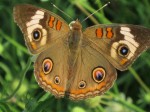 The garden is usually filled with butterflies in summer but often has few in spring. True, many are still sleeping, but you can attract those that are “out and about” by making your garden butterfly friendly. Just provide for the basic needs of butterflies and they will come. It’s easy and does not take a lot of money or gardening expertise.
The garden is usually filled with butterflies in summer but often has few in spring. True, many are still sleeping, but you can attract those that are “out and about” by making your garden butterfly friendly. Just provide for the basic needs of butterflies and they will come. It’s easy and does not take a lot of money or gardening expertise.
Butterflies need food, water, and shelter, just like other animals do. Of the three, food is the most specific. Different butterflies need different flowers for both themselves and their caterpillars so provide for both and you will double your chances of attracting them. Swallowtails adults, for example, like the nectar of numerous spring flowers including chives (Allium schoenoprasum), dame’s rocket (Hesperis matronalis), lilac (Syringa spp.), moss phlox (Phlox sublata), peony (Paeonia spp.), privet (Ligustrum spp.), crabapple (Malus spp.) and spicebush (Lindera benzoin). The female swallowtails will lay their eggs on the leaves of plants that will provide food for their ravenous caterpillars such as cherry (Prunus spp), lemon (Citrus limon), willow (Salix spp), parsley (Petroselinum spp.) rue (Ruta graveolens), and cottonwood (Populus spp.) depending on the kind of swallowtail. Other butterflies also like many of the flowers on the swallowtail nectar list. Chives, for example, will also attract fritillaries; moss phlox, painted ladies; and privet, red admirals. Willow and cottonwood will also provide food for viceroy and morning cloak caterpillars. Like buckeyes? Grow snapdragons (Anthirrhinum spp.) and clover (Trifolium repens, T. pratense) for adults and give a little space for plantain (Plantago lanceolata) for their caterpillars. If you have dandelions in your lawn or garden you may attract red admirals, sulphurs, and common blues. If your garden is a little short on flowers during the spring, put out overripe or damaged fruit such as grapes or bananas.
To make this easy, here’s a list of some spring flowers and the butterflies they will attract.
 Chives: swallowtails, fritillaries, painted ladies, red admirals
Chives: swallowtails, fritillaries, painted ladies, red admirals
 Clover: suphurs, blues, hairstreaks, crescents, buckeyes, white cabbage
Clover: suphurs, blues, hairstreaks, crescents, buckeyes, white cabbage
 Crabapple: swallowtails
Crabapple: swallowtails
 Dame’s rocket: swallowtails
Dame’s rocket: swallowtails
 Grape hyacinth: skippers, whites, suphurs, alfalfas
Grape hyacinth: skippers, whites, suphurs, alfalfas
 Lilac: swallowtails
Lilac: swallowtails
 Moss phlox: swallowtails, painted ladies, skippers
Moss phlox: swallowtails, painted ladies, skippers
 Peony: swallowtails, skippers
Peony: swallowtails, skippers
 Privet; swallowtails, red admirals,
Privet; swallowtails, red admirals,
 Spicebush: swallowtails
Spicebush: swallowtails
 Virginia bluebell: skippers, sulphurs
Virginia bluebell: skippers, sulphurs
All butterflies need water and the minerals it provides. In nature butterflies visit puddles so make an artificial one if you don’t have a natural one. Fill a shallow dish or tray with sand or gravel and fill it with water. The butterflies will probably come to your artificial puddle for a refreshment forming groups known as “puddle clubs”.
Finally, butterflies need shelter. Their wings are delicate and can be damaged by rain and wind. Trees and shrubs located near the plants that bearing nectar-producing flowers will cut the effect of the wind as they feed. Choose plants with large leaves and you give them a place to hide from both rain and predators.
Butterflies are cold blooded and need a safe place in the sun where they can warm up enough to fly. Rocks that absorb the heat of the sun and slowly let it off during the day are good places for the butterflies to warm themselves. These should be in a protected place where wind and predators can not disturb them as they prepare for flight.
Many of the spring blooming flowers are readily available and easy to grow so it doesn’t take a huge effort to provide for butterflies. But don’t expect to see the same number of butterflies that you do in the summer because many do not emerge as adults until summer. As the temperatures rise more plants will bloom and more butterflies will arrive in the garden ready to enjoy the nectar, find suitable plant leaves and lay their eggs. The more plants you provide the more butterflies will visit your garden.
